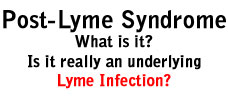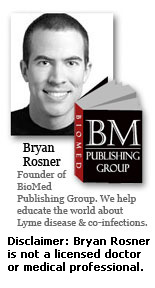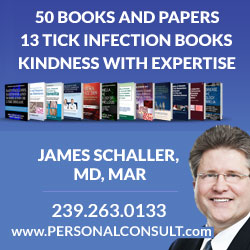Post-Lyme Syndrome: The Scoop
By Bryan Rosner on May 4, 2008 in Politics & Activisim
 In this post we will look at Post Lyme Syndrome – is it real or not? First, a little background. Current antibiotic guidelines set forth by the Centers for Disease Control are vastly inadequate and based on antiquated, inaccurate, and unreliable data.
In this post we will look at Post Lyme Syndrome – is it real or not? First, a little background. Current antibiotic guidelines set forth by the Centers for Disease Control are vastly inadequate and based on antiquated, inaccurate, and unreliable data.
While some people do get well by following these guidelines, a significant percentage do not. Many people remain sick despite a two or three week course of doxycycline or penicillin—the length and choice of antibiotic therapy which the Centers for Disease Control dogmatically and ignorantly insist is adequate treatment. Recent estimates suggest that up to 30% of Lyme Disease cases do not get resolved after following these CDC guidelines.
A preponderance of research establishing the necessity of extended courses of antibiotic therapy for the unlucky 30% has been completely ignored by medical regulatory agencies. As a result, symptoms and misery can continue for the unlucky 30% even though the “right treatment” was given. People who are still infected despite antibiotic therapy have what is referred to as chronic Lyme Disease. The chronic form of the disease is becoming an epidemic in the United States and abroad.
Or is it? A significant percentage of doctors and regulatory agencies do not recognize the existence of chronic Lyme Disease. The prevailing belief is that if someone has Lyme Disease and is treated with a several-weeklong course of antibiotics, they must, by definition, be cured. This belief fails to take into account the last 20 years of scientific research, as there have been numerous studies which evidence that Lyme Disease bacteria are often still present in the body even after antibiotic therapy. In fact, some studies show that common antibiotic regimens have very little effect on the bacterial infection.
Doctors and researchers who do not acknowledge chronic Lyme Disease have invented a bogus label for people who still have symptoms after a short course of antibiotics: “Post-Lyme Syndrome.” Patients abused with this diagnosis are either told that nonliving bacterial toxins are keeping them ill, or worse, that remaining symptoms are psychiatric in nature and they should see a shrink who treats hypochondria and paranoia. So, many patients end up attempting to treat a raging bacterial infection with talk therapy. The truth is that chronic Lyme Disease is in fact a real condition, caused by an active bacterial infection, and largely disparaged by conventional medicine.
The conclusion that chronic Lyme Disease is not a valid medical condition is so preposterous, so irrational, so unscientific that one can’t help but question whether the presiding research organizations are actually pursuing truth or instead, acting as puppets beholden to a political or medical agenda. There is simply too much research to ignore. And as time goes on, instead of behaving rationally and slowly examining new research and moving toward adoption of chronic Lyme Disease as a real condition, the regulatory agencies seem to be going in the opposite direction and becoming more adamant about their erroneous conclusions.
The doctors who recognize chronic Lyme Disease, and are willing to treat it, are few and far between. LLMDs use extended courses of very powerful antibiotics, sometimes in combinations of two or three drugs simultaneously, at much higher than FDA approved dosages, to try to help people with chronic Lyme Disease. Doctors who treat chronic Lyme Disease are heroes with good intentions, coming to the rescue when no one else will.
But even if patient and LLMD are able to connect, there are still additional obstacles. Unfortunately, LLMDs who do step out on a limb and actually try to help people with chronic Lyme Disease by reading the literature and implementing rational treatments are often persecuted, sued, disciplined by state medical boards, ridiculed, and at risk of losing their medical practice, as we have discussed in the previous section of the book. Increasing persecution and legal danger has led to the decision by many doctors not to treat Lyme Disease patients, or at least, to adhere to the inadequate treatment guidelines established by the government.
Although it is becoming increasingly perilous, many LLMDs are willing to brave the legal climate because some people with chronic Lyme Disease do recover by using extended courses of antibiotic therapy. In these cases, people who would have otherwise not recovered at all owe their lives to LLMDs. Offering hope to hopeless patients is the daily business of a Lyme Disease doctor.
Unfortunately, there are some very significant drawbacks to long-term antibiotic therapy. Patients receiving long-term antibiotic therapy often face grueling battles with insurance companies as a result of skyrocketing medical bills. Because official government standards indicate that only a short course of antibiotics is necessary in the treatment of Lyme Disease, many people are not able to get their extended treatment covered.
Another significant drawback to long-term antibiotic therapy is side effects. Because antibiotics are given in very high doses for long periods of time, side effects can be devastating. In some cases, the side effects can be worse than the disease. Many people end up with permanent damage to various organs caused by extended-course, high-dose antibiotic therapy.
The most significant drawback to long-term antibiotic therapy, though, is that it does not always work. The best antibiotics, given at high doses for months on end, often fail to eradicate the elusive and survival-oriented Lyme Disease bacteria. In these cases, symptom improvement can be fragile and relapses are common. “Open ended” antibiotic therapy is frequently required to keep some people stable. My first book, Lyme Disease and Rife Machines, has an in-depth explanation of exactly how and why antibiotics can fail.
The above treatment obstacles do not just exist in theory. The reality is that there are thousands of chronic Lyme sufferers who continuously live a miserable existence despite having attempted to get help from dozens of doctors.
As you can see, the situation can be quite hopeless. Lyme Disease sufferers are left to try to find answers on their own between doctors’ appointments where they are given anything from a diagnosis of paranoia to an inadequate course of antibiotics to a denial of insurance coverage. At every step in the diagnosis and treatment process, Lyme Disease sufferers encounter an uphill battle which often leads to prolonged sickness, financial ruin, and unimaginable stress. Many Lyme Disease sufferers live their lives in complete despair, having tried every antibiotic under the sun without lasting relief.
The bottom line on diagnosing and treating Lyme Disease is that there are many ways to end up with the infection but not many ways to get rid of it. This, as you may have guessed by now, is why we need breakthrough therapies for Lyme Disease.
Now you can see why a book on new Lyme Disease treatments is useful. This book was written because there is a need for this book. People who have failed to get well by using aggressive antibiotic therapy, or people who wish to avoid aggressive antibiotic therapy, will find alternatives on the following pages. After reading about the alternatives, Chapter 11 will provide practical guidance on how to integrate them into a complete treatment plan. Although there is no easy cure for chronic Lyme Disease, there are valuable treatment options which have improved the lives of thousands of people and in some cases, provided complete remission of symptoms. Yet, many of these treatments remain largely unknown. Hopefully this book will change that.








